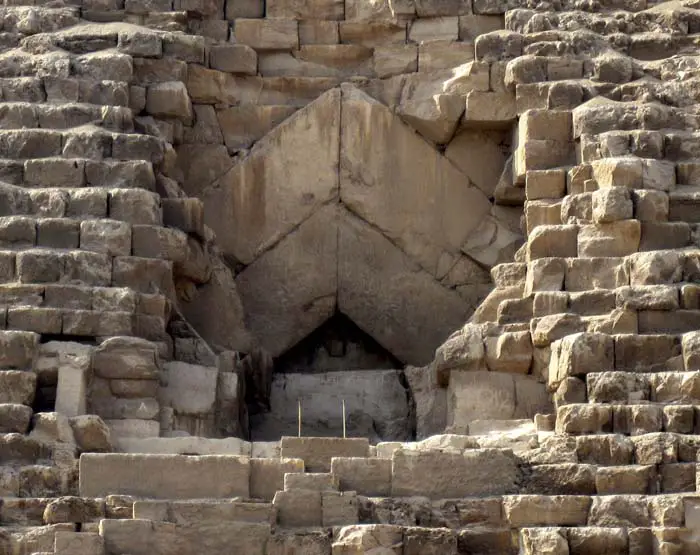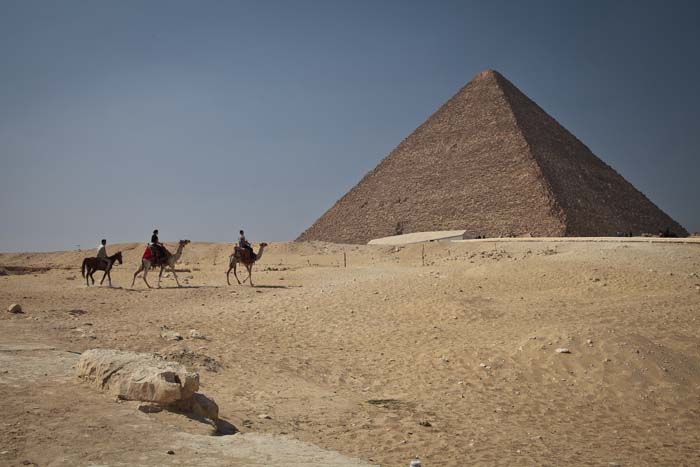Interior Design, Symbolism, and Furnishings
The interior of the Great Pyramid of Giza is more elaborate than most other pyramids and has three main chambers: a lower chamber which remains unfinished, a middle chamber called the Queen’s chamber, and an upper chamber called the King’s chamber. Above the King’s chamber are five smaller units called relieving chambers. Speculation is that these chambers were designed to protect the King’s chamber in case the roof collapsed, particularly since one wall in the King’s chamber is of limestone, which is a relatively soft rock. The relieving chambers are unfinished and apparently were intended to remain unseen.
Access to the pyramid is through an entrance 17 meters, or 56 feet, above the ground. Long, sloping corridors link the chambers and are separated at intervals by decorative doors and small anterooms. The interior remains a constant 20 degrees Celsius, or 68 degrees Fahrenheit, despite the sometimes blistering temperatures of the surrounding desert.
Shafts inside the pyramid were initially assumed to be for ventilation. However, modern research indicates that they were aligned properly for star-gazing at specific stars in the constellation of Orion. An Egyptian engineer named Robert Bauval discovered that the alignment of the three pyramids at Giza matched the alignment of stars in Orion’s Belt; other pyramids represented other stars in Orion’s Belt. According to research conducted by American astronomer Virginia Trimble, because of the direction of the shafts, they were intended to allow the Pharaoh’s soul to reunite with the stars when he died, which would enable his transition to a god.
Although there is a coffer in the King’s chamber and the pyramid was thought to have been intended as Khufu’s tomb, there is no evidence that anyone was ever buried in it. The coffer is too large to have been placed inside after construction was completed, therefore the coffer must have been placed inside beforehand and the structure erected around it.
Made of solid rose granite, modern-day analysis indicated that the tools needed for construction of the coffer were bronze saws between 8 and 9 feet long with sapphire teeth, as well as a fixed-point drill that used hard-jewel bits; at least 2 tons of drilling force would have been necessary. Another unusual correlation is that twice the perimeter of the coffer’s base multiplied by 10^8 yields the radius of the sun, or approximately 427,316 miles.
Originally, there did not appear to be any hieroglyphics inside the tomb, only a mark that indicated the work crew, and rolls of papyrus, which were discovered in 2013, that detailed the last few years of construction. However, research by the Djedi Project in 2011 revealed red-painted hieroglyphsin a chamber leading from a shaft in the Queen’s chamber upwards in the direction of the King’s chamber. At the end of one of these shafts, a British engineer named Waynman Dixon discovered a bronze tool and a black diorite ball.
Although the purpose of either remains a mystery, they may have been connected to a ceremonial rite called “the opening of the mouth” which a pharaoh’s son performed at his father’s death. The son had to open the mouth in order to restore life to his dead father and to ensure that the father could eat and drink in the afterlife. This rite was performed using the sacred adze, a tool made of meteoric iron, a rare metal in ancient Egypt.
Although many naysayers allege that the ancient Egyptians possessed little technological expertise, the sophisticated mathematics of Pi and Phi are evidenced in the construction of all the pyramids, particularly the Great Pyramid at Giza. Some scholars believe that the circular ratios are so mathematically accurate that the ancient Egyptians must have understood the concept of pi and phi; there is no other explanation for the accuracy of the construction.
Purpose of the Great Pyramid at Giza
Although some pyramids are indeed tombs, and some scholars think that was the purpose of the Great Pyramid, opinions now differ. The position of the shafts, the alignment of the Great Pyramid with its surrounding lesser pyramids, and the lack of evidence that anyone was buried in the pyramid, suggest that it may have had another purpose. It may have been intended as the site for a religious ceremonial ritual.
The Great Pyramid is one of only three pyramids to have had a swivel door. Although the door weighed approximately 20 tons, it was easily opened from the inside. Due to the precise fit of the door, it was difficult to locate when outside the pyramid and even when located, it lacked a place to latch onto; variations in the stone on the exterior are the only indications of a nearby opening. The other two pyramids that contain doors belonged to Khufu’s father and his grandfather.
 © Olaf Tausch – Entrance to the Great Pyramid
© Olaf Tausch – Entrance to the Great Pyramid
Originally, the Great Pyramid of Giza was covered with 144,000 casing stones that were highly reflective as well as protective. Made of polished white Tura limestone, they reflected the sun’s light and it is thought that they made the pyramid visible from space, thus the Egyptians’ name for it, “Ikhet”, or glorious light. The casing stones were laid in an interlocking pattern and held together with bond stones. The construction is so tight on the casing stones that a knife blade would not fit between them. In order to assure the longevity of appearance, the bond stones were laid with the same precision.
Not only did the casing stones provide a protective and beautiful mantle for the Great Pyramid, they provided structural integrity as well. In order to achieve the maximum structural integrity, the casing stones were not laid as decoration or as a mantle, but they were engineered to be an integral partof the structure of the pyramid.
A massive earthquake in 1303 AD loosened the casing stones and many were subsequently dislodged and stolen to be used for mosques and temples. The result has been that the Great Pyramid now has a rough exterior that has been eroded by the elements rather than the sleek and shimmering appearance it once had.
 © bobthemagicdragon – The Great Pyramid, rough exterior we are familiar with
© bobthemagicdragon – The Great Pyramid, rough exterior we are familiar with







































